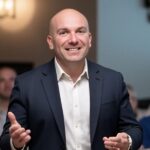By: Monica Stevens
For federal employees mapping out their retirement strategies, the passage of the SECURE 2.0 Act has ushered in key changes that could significantly impact their planning. From new rules around catch-up contributions to the prospect of higher future tax rates, the legislation is reshaping the landscape for federal workers.
One of the biggest revisions coming down the pike involves catch-up contributions to the Thrift Savings Plan (TSP) for federal employees. Beginning in 2026, eligible workers making catch-up contributions will have to make those additional payments into a Roth TSP account if their income exceeds a certain threshold set by the IRS.
“This is a major change that many of our federal employee clients need to be aware of and plan accordingly for,” explains David Fei, co-founder of PlanWell Financial Planning in Reston, VA. “The income limits will be adjusted annually, but we’re advising impacted clients to start modeling different scenarios now to understand the full implications.”
When the SECURE 2.0 Act first passed in late 2022, the initial wage threshold for mandatory Roth catch-up contributions was set at $145,000 for 2023 wages. Fei and his partner Brennan Rhule have been proactively discussing this new rule with applicable clients to help position them over the next couple of years.
Beyond the catch-up contribution change, the SECURE 2.0 Act also has significant tax planning ramifications for federal retirees in terms of when to take distributions from tax-deferred retirement accounts. If current laws remain unaltered, Americans could be facing substantially higher income tax rates once pre-Tax Cuts and Jobs Act levels return after 2025.
“We’re talking about potential income tax hikes of 3-4 percentage points or more for many of our federal employee clients,” says Rhule. “With taxes likely rising, we’re urging eligible federal workers to consider systematic Roth conversions over the next few years to allow more of their retirement savings to grow tax-free.” In addition, Roth conversions will reduce Requirement Minimum Distribution (RMD) burdens down the road that can drastically increase the cost of Medicare Part B premiums.
The duo emphasizes that developing an informed, customized plan is critical when it comes to navigating the changing tax landscape. Factors like future spending needs, anticipated income sources, state taxes and more must all be carefully evaluated.
Of course, tax planning is just one piece of the larger retirement strategy puzzle for federal employees. PlanWell Financial Planning has also been guiding clients through recent enhancements to the TSP itself. From an improved website and clearer statements to new withdrawal flexibility options, several user-friendly upgrades have been implemented.
However, Fei and Rhule note that the TSP still has blind spots that retirement investors need to be aware of, such as limited investment withdrawal tactics and potential inheritance issues. Their comprehensive federal retirement planning process aims to address all of these areas.
“Our decades of experience specializing in federal retirement has exposed us to all the potential pitfalls and planning opportunities,” says Fei. “We take a truly holistic approach, leaving no stone unturned so our federal employee clients can feel confident they’re maximizing their benefits.”
Both CERTIFIED FINANCIAL PLANNER™ holding the Chartered Federal Employee Benefits Consultant designation, Fei and Rhule have built PlanWell Financial Planning around an educational model designed to ensure federal workers fully understand their planning recommendations. Their goal is to be a trusted partner, not just give directions.
As the federal retirement landscape continues evolving with new legislation like SECURE 2.0, the two planners stress the importance of working with a fiduciary advisor who specializes in this complex arena. From tackling new contribution rules and tax strategizing to optimizing TSP investments and maximizing benefits, it’s an area where experienced guidance can pay dividends.
“There’s simply too much at stake for federal employees to go this alone or work with a generalist,” says Rhule. “Having a highly credentialed team in your corner can make a meaningful difference in your quality of life in retirement.”
In keeping with its mission of offering free financial education, Planwell Financial Planning hosts a series of federal retirement webinars. These virtual sessions aim to educate attendees on the intricacies of their FERS benefits, from pensions to TSP. Interested individuals can visit the webinar schedule at https://www.planwellfp.com/federal-retirement-webinar-workshop/.
Published by: Khy Talara



















